Podcast: Play in new window | Download
Subscribe: Apple Podcasts | RSS
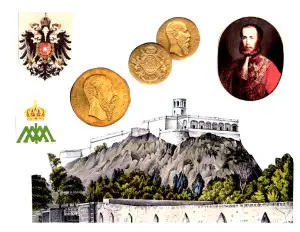 Many people are unaware that in the 1860s Mexico was an empire and was ruled by a man named Emperor Maximilian the First. Who was this man and how did he get control of Mexico? More importantly to this podcast, what became of his imperial treasure?
Many people are unaware that in the 1860s Mexico was an empire and was ruled by a man named Emperor Maximilian the First. Who was this man and how did he get control of Mexico? More importantly to this podcast, what became of his imperial treasure?
Everyone likes a good treasure story but before talking about the treasure we will set the stage and give context. Emperor Maximilian was born an Austrian Archduke, to the House of Habsburg, second son of Archduke Franz Karl and was the brother of the long-ruling Emperor Franz Josef. Maximilian was descended from Ferdinand and Isabella, and many of the other Spanish monarchs who ruled over Mexico as New Spain. In 1857 Maximilian married Princess Charlotte of Belgium the daughter of the King of the Belgians, Leopold I. She was also the first cousin of Queen Victoria, as they were both granddaughters of Francis Frederick, the Duke of Saxe-Coburg-Saalfeld. Yes, that’s a lot of genealogy to consider and if nothing else, it shows how well connected Maximilian and his wife were to the various European noble houses.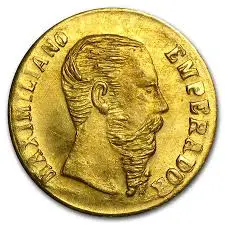
Mexico in the late 1850s was very tumultuous. After the Mexican War Santa Ana ruled as dictator and was later deposed by the republican forces led by Benito Juarez who was the first indigenous ruler of modern Mexico. Under the constitution of 1857 Juarez was formally elected president in 1861. Three European powers – France, Britain and Spain – had many financial interests in Mexico at the time and were upset about unpaid debts and overall political instability in that country. In 1861, the European trio sent a force to seize the customs house at Veracruz. Napoleon III of France spearheaded the effort and thought that having a permanent French military presence on Mexican soil would be a good way of securing French interests in Mexico. Napoleon’s first force to take over Mexico was defeated by the Mexicans at Puebla on May 5th 1862, now celebrated as Cinco de Mayo. The French didn’t stop there, though, and sent more troops, advancing on the capital, causing the republican government to collapse and Juarez to flee to the north, setting up his government in exile in Chihuahua. The power vacuum from the French invasion set the stage for the empire. A group from the Mexican aristocracy with the backing of Napoleon III of France approached Maximilian to offer him the Mexican crown. At first he said no, but when he had heard of a vote taken in Mexico that confirmed the proclamation of Empire, Maximilian and his wife Carlota renounced their European titles and in the spring of 1864 they headed for Mexico.
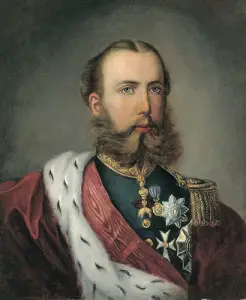
While not popular with most of the native-born Mexicans, the empire was supported by the elites who always looked to Europe and by Napoleon III who still maintained his army in Mexico to support Maximilian. The new emperor sought to recreate the imperial splendor of the court at Vienna and did so on the Aztec “Hill of the Grasshopper” – or Chapultepec – on the outskirts of Mexico City. Today you can see the imperial coaches, the fine furniture and other royal accoutrements in the museum at Chapultepec Castle in modern-day Mexico City. Maximilian’s rule was to be brief. An American blockade of the Mexican Gulf ports in 1866 initiated by Andrew Johnson was an attempt to drive the French out of Mexico. Napoleon III capitulated to the Americans and left Maximilian in Mexico to fend for himself. As the emperor had very little support among the people outside the small elite ruling class he must have known that without French military support, his days were numbered. After the French withdrawal Empress Carlota went to Europe to seek assistance for her husband’s regime among the various crowned heads of Europe and even from Pope Pius IX. She found no one to support her. As a result, exhausted and resigned to her fate, Carlota never returned to Mexico and suffered a mental breakdown. She, too, must have known the ultimate fate to befall her husband, and on June 19, 1867 Maximilian was shot by firing squad. Queen Victoria of England, one of the first people in Europe to hear of the emperor’s execution wrote in her diary, “The shocking news is true. Poor, dear cousin Charlotte, bereft of reason, and her husband killed. What a shocking end to their luckless undertaking, which I did all I could to prevent.”
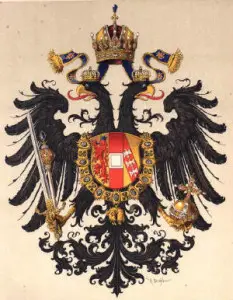 Maximilian arrived in Mexico with a small personal fortune and amassed more wealth during his tenure as emperor. In the final days of the empire, according to legend, and like many other rulers of Mexico who would follow him, Emperor Maximilian made arrangements to get his vast wealth out of the country. He knew that the ports were in rebel hands and the countryside was rife with banditry, so he thought it too risky to take his wealth out of the country overland and by sea by normal routes. Instead, he chose 4 Austrian officers and about a dozen Mexican loyalists to take the loot up north and through Texas to the port of Galveston. They loaded up 15 ox-pulled wagons full of $10 million of gold, silver and jewels and took a zig-zagged course while heading north to avoid pursuit. When the treasure train crossed the Rio Grande into Texas they camped at Presidio del Norte, presumably safe on the American side of the border. While in camp the group met 6 former Confederate soldiers from Missouri who were heading to Mexico rather than submit to Yankee rule. The Austrian captains asked if these men would postpone their trip to Mexico and help guide them across Texas to Galveston. They never told the Confederates what was in their cargo, and the Confederates agreed. Back then, Texas was a place still fraught with Comanche raids, banditry and a whole host of other hazards. Near the border of modern-day Upton and Crane counties, south of Odessa, where Route 385 is today, the Confederates found out the truth about what they had been escorting. They overpowered the Austrians and the Mexican loyalists, killing them, and taking the treasure for themselves. The story doesn’t end there. The 6 Confederates took some of the treasure with them, but buried the rest and set fire to the wagons over the spot where they buried the treasure. Their plan was to go back to Missouri, regroup, and return to get the rest of what they had buried. Along the way back to Missouri, though, one of them became really ill and had to be left behind at a place called Fort Concho. After a few days, although not fully recovered from his illness but feeling he might be cut out of the action, this man left the fort to try to catch up with his compatriots. A day into his journey he found them, all dead, the victim of a Comanche attack. So, this man who was still very ill was the only one left who knew the location of Maximilian’s imperial treasure. He kept going and on the way back to Missouri and too sick to travel farther, this man stopped in Denton, Texas and went to a doctor there to help cure him. The doctor told the Confederate that he didn’t have much time to live. And so the story goes, bedridden and knowing he would never recover the treasure for himself, the Confederate drew a crude map for the doctor and told him the story of Maximilian’s treasure. After the man’s death the doctor took a group of people to the border of Crane and Upton counties to hunt for the treasure, but after weeks of trying they never found it.
Maximilian arrived in Mexico with a small personal fortune and amassed more wealth during his tenure as emperor. In the final days of the empire, according to legend, and like many other rulers of Mexico who would follow him, Emperor Maximilian made arrangements to get his vast wealth out of the country. He knew that the ports were in rebel hands and the countryside was rife with banditry, so he thought it too risky to take his wealth out of the country overland and by sea by normal routes. Instead, he chose 4 Austrian officers and about a dozen Mexican loyalists to take the loot up north and through Texas to the port of Galveston. They loaded up 15 ox-pulled wagons full of $10 million of gold, silver and jewels and took a zig-zagged course while heading north to avoid pursuit. When the treasure train crossed the Rio Grande into Texas they camped at Presidio del Norte, presumably safe on the American side of the border. While in camp the group met 6 former Confederate soldiers from Missouri who were heading to Mexico rather than submit to Yankee rule. The Austrian captains asked if these men would postpone their trip to Mexico and help guide them across Texas to Galveston. They never told the Confederates what was in their cargo, and the Confederates agreed. Back then, Texas was a place still fraught with Comanche raids, banditry and a whole host of other hazards. Near the border of modern-day Upton and Crane counties, south of Odessa, where Route 385 is today, the Confederates found out the truth about what they had been escorting. They overpowered the Austrians and the Mexican loyalists, killing them, and taking the treasure for themselves. The story doesn’t end there. The 6 Confederates took some of the treasure with them, but buried the rest and set fire to the wagons over the spot where they buried the treasure. Their plan was to go back to Missouri, regroup, and return to get the rest of what they had buried. Along the way back to Missouri, though, one of them became really ill and had to be left behind at a place called Fort Concho. After a few days, although not fully recovered from his illness but feeling he might be cut out of the action, this man left the fort to try to catch up with his compatriots. A day into his journey he found them, all dead, the victim of a Comanche attack. So, this man who was still very ill was the only one left who knew the location of Maximilian’s imperial treasure. He kept going and on the way back to Missouri and too sick to travel farther, this man stopped in Denton, Texas and went to a doctor there to help cure him. The doctor told the Confederate that he didn’t have much time to live. And so the story goes, bedridden and knowing he would never recover the treasure for himself, the Confederate drew a crude map for the doctor and told him the story of Maximilian’s treasure. After the man’s death the doctor took a group of people to the border of Crane and Upton counties to hunt for the treasure, but after weeks of trying they never found it.
The story doesn’t end there. In 1937 a man named “Doc” Noss claimed to find a treasure in the San Andres Mountains of New Mexico hundreds of miles from the supposed site of the Confederates’ treasure burial. Included among the items found in a cave in Victorio Peak, it is rumored, were gold bars and the jewel-encrusted crown of Empress Carlota. Many believe that Doc Noss’ claims were fake and were only part of a scheme to sell shares in the excavation of the treasure. The supposed treasure at Victorio Peak is a whole other story and the subject of countless tall tales and rumors. What happened to the treasure of Emperor Maximilian is truly unknown. What was the fate of that $10 million in precious metals and jewels?
And here is a curious footnote to this treasure story. The last surviving player in the Mexican Empire tragedy, ironically, was the Empress Carlota who lived well into the 20th Century and died in 1927. I will quote the final paragraph in Joan Haslip’s book The Crown of Mexico:
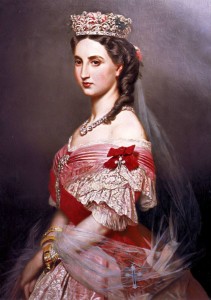 “Sixty years later, an old lady of 86, whom her attendants still addressed as ‘Imperial Majesty,’ died peacefully in a moated castle in Belgium. For over half a century she had lived in a dream world, peopled by shadows, ignoring the happenings of the world outside her castle gates, the fall of dynasties – Bonaparte, Hapsburg and Hohenzollern – the march of armies, the flames of war, the passing of generations. Only, every year, as the spring came round and the buds burst into blossom, she would go down to the little boat which was anchored in the moat and, stepping into it, turn to her attendants saying in the voice which had remained so young, “Today we leave for Mexico.”
“Sixty years later, an old lady of 86, whom her attendants still addressed as ‘Imperial Majesty,’ died peacefully in a moated castle in Belgium. For over half a century she had lived in a dream world, peopled by shadows, ignoring the happenings of the world outside her castle gates, the fall of dynasties – Bonaparte, Hapsburg and Hohenzollern – the march of armies, the flames of war, the passing of generations. Only, every year, as the spring came round and the buds burst into blossom, she would go down to the little boat which was anchored in the moat and, stepping into it, turn to her attendants saying in the voice which had remained so young, “Today we leave for Mexico.”
REFERENCES (Not a complete or formal bibliography)
The Crown of Mexico: Maximilian and his Empress Carlota by Joan Aslip
Maximilian, Mexico and the Invention of Empire by Kristine Ibsen
Recollections of my Life by Maximilian I of Mexico

18 thoughts on “The Lost Treasure of Emperor Maximilian”
Has anybody found Maximilian treasure
No, not yet!
The infamous treasure was actually travelling to Santa Fe, escorted by guards and a couple of priests. Apache Indians attacked the wagons near the Caballo Mountains on the infamous route – Jornada del Muerto (Present day Highway 25, near Truth or Consequences, NM). The guards were killed and the priests spared. The Indians sent one wagon away with the priests on it and the remaining wagons were taken INTO and underground in Caballo Mountains. Doc Noss was an avid explorer and treasure hunter in this area in the 1920s/30s. He did find a passage leading underground in the Caballo Mountains and the wagons left by the Indians there. Doc moved much of the treasure over a period of time, hiding these valuables in different places. Some of the treasure he even kept in his home in Hatch, NM. The \\\”crown\\\” was one of the items he kept in his home. Doc\\\’s wife, Ova, on one occasion, took the crown to a butcher shop to have it weighed by him. The crown weighed over 6 pounds. Ova shared her experience with Doc, not realizing it would infuriate him. Upon learning of what Ova had done, Doc took whatever treasure was in the house, loaded up his car and drove off. He did not return until 3 days later. It\\\’s believed he re-hid the treasure in different locations of Ash Canyon 1 and Ash Canyon 2, near Elephant Butte (backside of the Caballo Mountain range off of Highway 51), in an area considered to be part of Palomas. I knew the Noss family historian in 2008, (John Clarence, aka. Jack ######) and he shared with me some of the contents of recorded conversations between himself and Ova Noss, He did eventually write a book about Doc and all the characters he ran with. The book is actually a trilogy of books titled The Gold House. The books are painfully detailed, but very informative. There\\\’s no doubt that Doc got his hands on some of Max\\\’s treasure, as well as copious amounts of Spanish gold. I recommend searching in the Palomas region of the Caballo Mountains if you want to find something left behind by Doc. Good luck!!!
WOW. Thanks for sharing!!
Read my historical fiction novel ‘Imperial Legacy’ available on Amazon. It’s a talks about the Maximilian Treasure and the Imperial Crown Jewels that went down in a ship wrece off the cost of Virginia ten years later. Talk about a lost treasue. Divers are still looking for that.
Yes, a week before JFK was killed, he and LBJ flew there to see the gold.
JFK wanted the gold to go to Doc Noss but LBJ wanted it for himself and
if JFK died, LBJ would be the decider of who gets the gold.
Why do you think he had a big runway built next to his presidential library ?
That some very interesting information and one more thing to add to the JFK story. Thanks for sharing!
You still around Bob???
Anybody wants to go treasure hunting let me know.I live in Texas
I’d love to, but I have little time these days. Thanks for the offer.
I’m in Midland. I’ve thought about this for years.
I bought a large silverChaise Lounge in San Antonio, Texas, 20 years ago. At that time it was $5000.00. I would like to sell this lovely piece who belonged to Emperor Maximilian of Mexico (1832-1867)
Do you know of a connection who would be interested in purchasing this piece of Mexican History.
Ir an be seen in Fresno, Ca.
Cool. I wish I was well connected and could help you. I will leave this here for people to respond.
The emperor’s team carrying the treasure split into three groups. 2 ended in Texas, and the third, NM. I believe the government has already taken control of the other two, Texas findings and silenced the witnesses but cannot remember. Im in Dallas if anyone has further information.
Peace, Love, and Texas Freedom from the union.
Great post. Thanks. So, you want Texas to be independent again?
Do you know where I could find proof of this? I have heard this from others as well but I have never found evidence to back it up. I live about 15 min from Castle Gap where the treasure was supposedly buried. Please don’t take me asking for proof as a way of calling you a liar, I am just looking for actual references to the story, Finding any hard proof has not been easy so far.
Hi Brandon, The published accounts are sometimes stories of stories of stories. The only references I have I cited at the end of the show. Maybe you should go out and look? I might be up for an adventure myself.
I think Maximilian’s lost treasure is a myth. It isn’t true that Napoleon III left Maximilian to fend for himself. When Napoleon III withdrew his troops, he urged Maximilian to come with them. For whatever reason, Maximilian refused. He probably was committed to the idea that his duty was to serve Mexico, and he never made any attempt to escape the country., Instead, he recruited loyalists who fought for him until he was captured at Querétaro, and soon thereafter. If he really had a treasure that he intended to use later, he could certainly sent it out with the French Army, much better than trusting to four men to carry it through the USA, where Maximilian would hardly have been welcome. ;This story is one of the first urban legends.